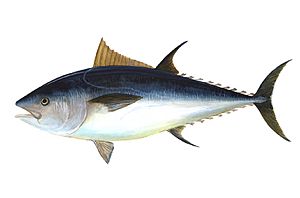Teleostomes facts for kids
Quick facts for kids Teleostomes |
|
|---|---|
 |
|
| The Atlantic bluefin tuna | |
| Scientific classification |
|
| Kingdom: | Animalia |
| Phylum: | Chordata |
| Clade: | Eugnathostomata |
| Clade: | Teleostomi C. L. Bonaparte, 1836 |
| Subgroups | |
|
|
Teleostomi is a large group of fish that have jaws. It includes some fish that are now extinct, like the Acanthodii (often called 'spiny sharks'). It also includes all the Osteichthyes, which are known as 'bony fish'.
Teleostomes have two special features that help them breathe. First, they have an operculum. This is a set of bones that cover and protect their gills. Second, they developed a simple lung. This early lung helped them breathe air.
Scientists sometimes group Teleostomes in different ways. Some see them as a clade, which is a group of organisms that share a common ancestor. Others call them a crown group. This means they include the last common ancestor and all its descendants.
Contents
What are Teleostomes?
Teleostomes are a very important group of animals. They are part of the larger group called Gnathostomata. This name means 'jawed mouth'. It includes all animals with jaws, from fish to humans.
Most fish you know today are Teleostomes. This group first appeared a very long time ago. They have been around since the Silurian period. That was about 445 million years ago!
Key Features of Teleostomes
Teleostomes have some unique features. These features helped them survive and spread.
Breathing with Gills and Lungs
One key feature is their breathing system. They have an operculum. This bony flap covers their gills. It helps them pump water over their gills. This means they can breathe even when they are not swimming. It is like a built-in pump.
They also developed a simple lung. This lung was not like our lungs today. It was more like a sac that could hold air. It helped them breathe in water that had low oxygen. Over time, this lung evolved into different things. In some fish, it became a swim bladder. This helps fish float. In other animals, it became the lungs we see in land animals.
Bony Skeletons
Another important feature is their skeleton. Most Teleostomes have a skeleton made of bone. This is different from sharks and rays, which have skeletons made of cartilage. A bony skeleton is strong and provides good support. It allows for more complex movements.
Types of Teleostomes
The Teleostomi group is divided into two main parts. One part is now extinct. The other part includes almost all fish alive today.
Acanthodii: The Spiny Sharks
The Acanthodii are an extinct group. They are often called 'spiny sharks'. They lived a very long time ago. These fish had many sharp spines on their fins. They looked a bit like sharks. But they were not true sharks. They are important because they are some of the earliest known jawed fish. They help us understand how fish evolved.
Osteichthyes: The Bony Fish
The Osteichthyes are the 'bony fish'. This is a huge group. It includes almost all the fish you can imagine. From tiny guppies to giant tuna, they are all bony fish.
The bony fish are divided into two main subgroups:
- Actinopterygii: These are the 'ray-finned fish'. Most fish you see are ray-finned. Their fins are supported by bony rays. This group includes salmon, cod, goldfish, and many more. They are the most diverse group of vertebrates.
- Sarcopterygii: These are the 'lobe-finned fish'. Their fins are fleshy and muscular. They have a central bone structure. This group includes lungfish and coelacanths. What is really cool is that land animals, like humans, evolved from lobe-finned fish! So, in a way, we are also part of the Teleostomi family tree.
Evolution and History
Teleostomes first appeared in the Silurian period. This was over 400 million years ago. They quickly became very successful. Their bony skeletons and advanced breathing systems gave them an edge.
Over millions of years, they spread into all kinds of water environments. They adapted to fresh water, salt water, and even deep oceans. Their ability to breathe using an operculum and a primitive lung helped them survive in many different places.
The evolution of the lobe-finned fish (Sarcopterygii) was a huge step. Some of these fish developed stronger, more limb-like fins. These fins eventually allowed them to move onto land. This led to the evolution of all four-legged animals, including amphibians, reptiles, birds, and mammals.
Why are Teleostomes Important?
Teleostomes are incredibly important for many reasons.
- Biodiversity: They make up the vast majority of all fish species. They live in almost every water habitat on Earth.
- Ecosystems: They play vital roles in aquatic ecosystems. They are a food source for many animals. They also help control populations of smaller organisms.
- Human Life: Many Teleostomes are important for food. Fishing industries around the world rely on them. They are also popular as pets and in aquariums.
- Understanding Evolution: Studying Teleostomes helps us understand how life evolved. They show us how animals moved from water to land. They also show how jaws and bony skeletons developed.
See also

- In Spanish: Teleostomi para niños

